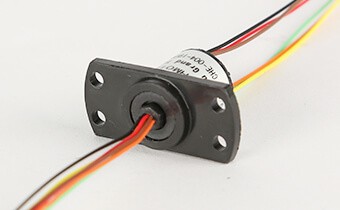Slip ring with flange is common in rotating equipment such as wind turbines, cranes, and robots, as they are critical components that transmit signals and power between stationary and rotating parts. But why do these slip rings need to have flanges? In this article, we will explore the reasons for using flanges in slip rings.
Answering the Questions
What Is a Slip Ring?
Before we think about why some slip rings need flanges, we need to understand what a slip ring is. A slip ring, also known as a rotary electrical joint, is an electrical connector designed to transmit power and signals from a stationary component to a rotating component. The electrical connection is established between the two through brushes or contacts that slide on the rotating surface of the slip ring.
Why Do Slip Rings Need Flanges?
Through the above understanding of what is a slip ring, in this part, we will talk about why slip rings need flanges. First, understand what is a flange. Flanges are ring-like structures attached to the slip ring housing and they act as a mounting platform for the rotor. Since slip rings are used in rotating equipment, they are subject to various forces such as vibration, shock, and centrifugal force, and flanges help absorb these forces, just to provide mechanical support for the rotating equipment they are installed on.
Types of Flanges
There are mainly two types of flanges used in slip rings- internal and external flanges. Internal flanges are mounted inside the slip ring housing, and the rotor is mounted on the inside of the flange. On the other hand, external flanges are mounted outside the slip ring housing, and the rotor is mounted on the outside of the flange.
Benefits of Using Slip Rings with Flanges
Using slip rings with flanges offers several benefits, such as:
Enhanced Stability: Flanges provide additional stability to the slip ring, reducing the chances of it vibrating or moving around during operation.
Better Performance: The use of flanges also improves the performance of slip rings by ensuring a more consistent electrical connection between the rotor and stator.
Easy Installation: Flanges make the installation of slip rings more straightforward and secure, reducing the chances of the slip ring coming loose during operation.
Conclusion
In conclusion, slip rings with flanges are critical components used in rotating machinery. Flanges provide mechanical support to the slip ring, ensuring its stability and preventing damage to the equipment it is installed in. The use of flanges also improves the performance of slip rings, ensuring a more consistent electrical connection between the rotor and stator.
If you have any questions or would like to share your thoughts on this topic, please leave a comment below.
Frequently Asked Questions
Q. What Is the Difference Between Internal and External Flanges?
A. Internal flanges are mounted inside the slip ring housing, and the rotor is mounted on the inside of the flange. On the other hand, external flanges are mounted outside the slip ring housing, and the rotor is mounted on the outside of the flange.
Q. Can Slip Rings Be Used in Harsh Environments?
A. Yes, slip rings are designed to operate in harsh environments and can withstand high temperatures, humidity, and corrosive atmospheres.
Q. What Are the Other Components of a Slip Ring?
A. In addition to the rotor and stator, slip rings also consist of brushes or contacts that slide on the rotating surface of the slip ring to make the electrical connection between the two.
See What We Can Do

